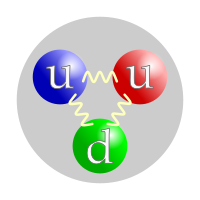
Photo from wikipedia
The hypothesis that strange quark matter is the true ground state of matter has been investigated for almost four decades, but only a few works have explored the dynamics of… Click to show full abstract
The hypothesis that strange quark matter is the true ground state of matter has been investigated for almost four decades, but only a few works have explored the dynamics of binary systems of quark stars. This is partly due to the numerical challenges that need to be faced when modelling the large discontinuities at the surface of these stars. After adopting a suitable definition of the baryonic mass of strange quark matter (SQM) we introduce a novel technique in which a very thin crust is added to the equation of state of SQM to produce a smooth and gradual change of the specific enthalpy across the star and up to its surface. The introduction of the crust has been carefully tested by considering the oscillation properties of isolated quark stars, showing that the response of the simulated quark stars matches accurately the perturbative predictions. Using this technique, we have carried out the first fully general-relativistic simulations of the merger of quark-star binaries finding several important differences between quark-star binaries and hadronic-star binaries with the same mass and comparable tidal deformability. In particular, we find that the dynamical mass loss is ∼ 20% smaller than that coming from a corresponding hadronic binary. In addition, quark-star binaries have merger and post-merger frequencies that obey the same quasi-universal relations derived from hadron stars if expressed in terms of the tidal deformability, but not when expressed in terms of the average stellar compactness. Hence, it may be difficult to distinguish the two classes of stars if no information on the stellar radius is available. Finally, differences are found in the distributions in velocity and entropy of the ejected matter, for which quark-stars have much smaller tails. Whether these differences in the ejected matter will leave an imprint in the electromagnetic counterpart and nucleosynthetic yields remains unclear, calling for the construction of an accurate model for the evaporation of the ejected quarks into nucleons.
Journal Title: Physical Review D
Year Published: 2021
Link to full text (if available)
Share on Social Media: Sign Up to like & get
recommendations!